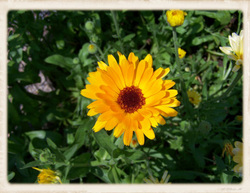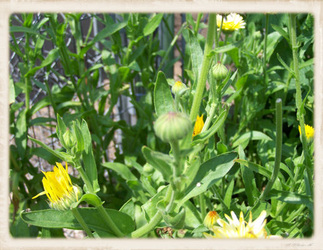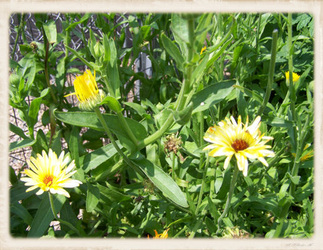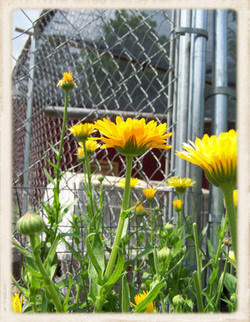Calendula officinalis
[ka-LEN-dew-luh oh-fiss-ih-NAH-liss]
Family: Asteraceae (Composite)
Names: Pot Marigold, Summer's Bride, Husbandman's Dial, Holigold, Marybud,
Marygold, Bride of the Sun, Spousa Solis, Golds, bull flower; butterwort, care, cowbloom, death-flower, drunkard, golden flower of Mary, gouls, goulans, kingcups, holygold, sun’s bride, water dragon, yolk of egg, poet’s marygold, publican and sinner, ruddles, Scotch marigold, shining herb, solsequia, Gold; Ringelblume, Studentenblume, Totenblume, Goldblume (German); souci (French); calendula (Italian); Nagietek lekarski (Polish); goedsbloemwratten-
kruid (Dutch); calendula gialla, fiorrancio, calenzola (Italian); calendula, flamenquilla, maravilla, flor de muerto (Spanish); maravilhas, marianas (Portuguese); ringblomma (Swedish); nogotki, lekarstvennye (Russian); chin-chan-hua (Chinese); janvah, azariyunah, azarboya (Arabic)
Description: Native to Asia and southern Europe and was brought to America by early settlers. Introduced to Britain by the Romans. Calendula is a flowering annual that grows to a height of twelve to eighteen inches. The stem is slightly fuzzy and the leaves are soft, long (growing to 6"), pale green. The root is a long spindly taproot. Flowers may be yellow or orange. The flowers are about one and one-half inches in diameter, consisting of concentric rows of ray florets surrounding the smaller ones making up the center disc.
Cultivation: Direct seed in the garden once the last chance of frost has past or plants can be put out before the last frost being careful not to injure the long taproot when transplanting. Germination is 7-10 days at a very high percentage if the seed is of good quality. The young seedlings are susceptible to damping off so take care to have good drainage and ventilation. Prefers a moderately healthy soil with average drainage and a pH of 5-8 but will grow in a wide range of soils. They prefer full sun or partial shade. A second planting can be made at the beginning of July to ensure a fall harvest. Thin plants to 12 inches apart. If you dehead the plant religiously in spring and summer it may produce more flowers as the weather turns cooler. Irrigation needs are on the high side so it’s recommended to water once or twice a week depending on the temperature, humidity and soil type. Cultivation should be done soon after transplanting and probably one more time before it becomes unnecessary due to the short life of the crop in the field. Pests include blister beetles, aphids and cucumber beetles. Best way to deal with pests is to pick the flowers often so there is little time for the pests to feed. Cucumber beetles are extremely difficult to deal with except with strong botanicals like rotenone.
Flower harvest can start as early as late May in warm areas. You can pick a particular planting three times a week until productivity goes way down, which is usually after 6-8 weeks. Harvests start to diminish in the late plantings after the first frost. The best time to pick is in the heat of the day when the resins are highest and the water content the lowest. Never let the flowers develop to the point where the seed is forming or you will greatly diminish your harvest totals.
The flowers should be dried as soon as possible as they tend to heat up and decompose if kept in the sun or in your harvest bucket. The petals dry quickly but the receptacle does not so you can expect a total drying time of 10 days or more at 90 degrees or so. Some growers advocate quick drying at high temperatures of 120 degrees which dries them in 5-7 days. They must also be sorted carefully as they reabsorb moisture readily. Dry flower yields of 400-600 pounds per acre can be expected. An acre would require a crew of 3-4 picking nearly every afternoon for 3-4 months.
[ka-LEN-dew-luh oh-fiss-ih-NAH-liss]
Family: Asteraceae (Composite)
Names: Pot Marigold, Summer's Bride, Husbandman's Dial, Holigold, Marybud,
Marygold, Bride of the Sun, Spousa Solis, Golds, bull flower; butterwort, care, cowbloom, death-flower, drunkard, golden flower of Mary, gouls, goulans, kingcups, holygold, sun’s bride, water dragon, yolk of egg, poet’s marygold, publican and sinner, ruddles, Scotch marigold, shining herb, solsequia, Gold; Ringelblume, Studentenblume, Totenblume, Goldblume (German); souci (French); calendula (Italian); Nagietek lekarski (Polish); goedsbloemwratten-
kruid (Dutch); calendula gialla, fiorrancio, calenzola (Italian); calendula, flamenquilla, maravilla, flor de muerto (Spanish); maravilhas, marianas (Portuguese); ringblomma (Swedish); nogotki, lekarstvennye (Russian); chin-chan-hua (Chinese); janvah, azariyunah, azarboya (Arabic)
Description: Native to Asia and southern Europe and was brought to America by early settlers. Introduced to Britain by the Romans. Calendula is a flowering annual that grows to a height of twelve to eighteen inches. The stem is slightly fuzzy and the leaves are soft, long (growing to 6"), pale green. The root is a long spindly taproot. Flowers may be yellow or orange. The flowers are about one and one-half inches in diameter, consisting of concentric rows of ray florets surrounding the smaller ones making up the center disc.
Cultivation: Direct seed in the garden once the last chance of frost has past or plants can be put out before the last frost being careful not to injure the long taproot when transplanting. Germination is 7-10 days at a very high percentage if the seed is of good quality. The young seedlings are susceptible to damping off so take care to have good drainage and ventilation. Prefers a moderately healthy soil with average drainage and a pH of 5-8 but will grow in a wide range of soils. They prefer full sun or partial shade. A second planting can be made at the beginning of July to ensure a fall harvest. Thin plants to 12 inches apart. If you dehead the plant religiously in spring and summer it may produce more flowers as the weather turns cooler. Irrigation needs are on the high side so it’s recommended to water once or twice a week depending on the temperature, humidity and soil type. Cultivation should be done soon after transplanting and probably one more time before it becomes unnecessary due to the short life of the crop in the field. Pests include blister beetles, aphids and cucumber beetles. Best way to deal with pests is to pick the flowers often so there is little time for the pests to feed. Cucumber beetles are extremely difficult to deal with except with strong botanicals like rotenone.
Flower harvest can start as early as late May in warm areas. You can pick a particular planting three times a week until productivity goes way down, which is usually after 6-8 weeks. Harvests start to diminish in the late plantings after the first frost. The best time to pick is in the heat of the day when the resins are highest and the water content the lowest. Never let the flowers develop to the point where the seed is forming or you will greatly diminish your harvest totals.
The flowers should be dried as soon as possible as they tend to heat up and decompose if kept in the sun or in your harvest bucket. The petals dry quickly but the receptacle does not so you can expect a total drying time of 10 days or more at 90 degrees or so. Some growers advocate quick drying at high temperatures of 120 degrees which dries them in 5-7 days. They must also be sorted carefully as they reabsorb moisture readily. Dry flower yields of 400-600 pounds per acre can be expected. An acre would require a crew of 3-4 picking nearly every afternoon for 3-4 months.
History: The word calendula is derived from the Latin calens meaning the first day of each month because the Romans claimed they bloomed the first of each month. Christians called it "marygold" and "marybud" because it bloomed at all the festivals celebrating the Virgin Mary, also because people believed by constant association with the flowers they could ward off evil. It should not be confused with Tagetes also called "marigold". Known as the "herb of the sun" because the flowers open in the morning and close in the evening. Mentioned as such in Shakespeare's A Winter's Tale. The French name gauche-fer, meaning left-hand iron, was coined because the brilliant yellow marigold flower was thought to resemble the polished shield worn by warriors on the left arm. The culinary use of calendula dates back to ancient Rome. Common people couldn't afford to buy saffron and they discovered that powdered calendula petals were an excellent substitute which is why it has been called "poor man's saffron".
There are many stories about calendula. One is the story of the four wood nymphs who fell in love with Apollo, the sun god. The nymphs became so jealous of one another they began neglecting their duties to Apollo's sister, the goddess Diana. She turned them into four dull-white marigolds, which distressed Apollo, but his only recourse was to send down his most brilliant rays to color them gold. In German folklore, rain was predicted if the flowers remained closed after 7 am. In India, Buddhists held pot marigold sacred to the goddess Mahadevi, who carried a trident emblem adorned with the flowers, while her followers crowned themselves with marigolds at her festival. Marigold was commonly used as an aphrodisiac, and thought to have great significance in love. Planting marigold in the footsteps of a loved one was supposed to tie him to his beloved. An old legend held that if a maiden touches a pot marigold with her bare foot she would be able to understand the language of birds. In the Middle Ages in Europe it was believed that those who wore marigolds would have a vision of anyone who had robbed them. Spanish sorcerers were said to wear it as a talisman. Traditionally it was picked when the Sun entered the sign of Virgo and the picker had to carry a wolf’s tooth wrapped in a bay leaf. In Mexico it is thought to be a flower of death and is believed to have spring from the blood of the Indians killed by the Spanish invaders.
Xochiquetzal, the Aztec love goddess, taught her people the message of the marigold, the petalled book of the cycles of life, of seed to leafy stem, of leafy stem to bud, of bud to flower open to the Sun, of flowers to drying petals that were the womb for the seed – to complete the cycle. Offerings of marigold petals were made to her. In the early days of this country dried marigold petals were sold in country stores out of a wooden barrel just like other herbs. The practice of coloring butter made from autumn and winter milk--low in vitamin A and pale
compared to spring butter--with skin-healing calendula was so common that butter became widely known as a burn ointment. The pigmentation of ornamental fish in captivity can be intensified by adding Calendula to regular fish food.
There are many stories about calendula. One is the story of the four wood nymphs who fell in love with Apollo, the sun god. The nymphs became so jealous of one another they began neglecting their duties to Apollo's sister, the goddess Diana. She turned them into four dull-white marigolds, which distressed Apollo, but his only recourse was to send down his most brilliant rays to color them gold. In German folklore, rain was predicted if the flowers remained closed after 7 am. In India, Buddhists held pot marigold sacred to the goddess Mahadevi, who carried a trident emblem adorned with the flowers, while her followers crowned themselves with marigolds at her festival. Marigold was commonly used as an aphrodisiac, and thought to have great significance in love. Planting marigold in the footsteps of a loved one was supposed to tie him to his beloved. An old legend held that if a maiden touches a pot marigold with her bare foot she would be able to understand the language of birds. In the Middle Ages in Europe it was believed that those who wore marigolds would have a vision of anyone who had robbed them. Spanish sorcerers were said to wear it as a talisman. Traditionally it was picked when the Sun entered the sign of Virgo and the picker had to carry a wolf’s tooth wrapped in a bay leaf. In Mexico it is thought to be a flower of death and is believed to have spring from the blood of the Indians killed by the Spanish invaders.
Xochiquetzal, the Aztec love goddess, taught her people the message of the marigold, the petalled book of the cycles of life, of seed to leafy stem, of leafy stem to bud, of bud to flower open to the Sun, of flowers to drying petals that were the womb for the seed – to complete the cycle. Offerings of marigold petals were made to her. In the early days of this country dried marigold petals were sold in country stores out of a wooden barrel just like other herbs. The practice of coloring butter made from autumn and winter milk--low in vitamin A and pale
compared to spring butter--with skin-healing calendula was so common that butter became widely known as a burn ointment. The pigmentation of ornamental fish in captivity can be intensified by adding Calendula to regular fish food.
Constituents: essential oil, carotenoid;flavanoids; sterol; mucilage; saponins;carotones; bitter glycosides; triterpenes; resin
Character: slightly bitter, pungent, drying, gently cooling
Meridians/Organs affected: liver, heart,lungs
Key Actions: anti-inflammatory; relieves muscle spasms; astringent; prevents hemorrhaging; heals wounds; antiseptic; detoxifying; mildly estrogenic
Cosmetic Use: The yellow or orange flowers produce a dye for the hair which women used in 16th century Europe. Marigold water is soothing to the eyes and the flowers provide a face cream which leaves the skin smooth and silky. When infused in water, marigold blooms make a tea that, when sipped, tones up a lazy circulation. It is also said to alleviate varicose veins. Since the blooms have healing properties the cooled infusion is valuable as a skin tonic for oily, blemished complexions. It can also be used as a rich skin moisturizer, a hair shampoo and a rinse, the latter being particularly useful in highlighting the tints in brown and reddish hair.
Medicinal Uses: Throughout the ages, tinctures made from calendula blossoms have been used to treat headaches, toothaches and even tuberculosis. The ancient Romans used calendula to treat scorpion bites and soldiers in the American Civil War found it helped stop wounds from bleeding. There is nothing better for sore or inflamed eyes than to bathe them in marigold water. (Place a large handful of flowers in a saucepan and add 1/2 pint water. Simmer for 20 minutes, strain and use while slightly warm.) Calendula is a popular salve and cream ingredient because it decreases the inflammation of sprains, stings, varicose veins and other swellings and soothes burns, sunburn, rashes and skin irritations.
Laboratory studies show it kills bacteria and fungus such as ringworm, athlete's foot. It is gentle enough to be applied as a tea to thrush in children's mouths. Taken internally, it has been used traditionally to promote the draining of swollen lymph glands, such as in tonsillitis and as part of the therapy for uterine or breast cancer, both as a poultice and as a tea. Herbalists report success in using a swab of calendula preparation or calendula boluses to treat abnormal cervical cells. Some antitumor activities have been observed in scientific studies. The infusion or tincture helps inflammatory problems of the digestive system such as gastritis, peptic ulcers, regional ileitis and colitis. Calendula has long been considered a detoxifying herb, and helps to treat the toxicity that underlies many fevers and infections and systemic skin disorders such as eczema and acne. The herb is also considered cleansing for the liver (promotes bile production) and gallbladder and can be used to treat problems affecting these organs. Makes a healing mouthwash for gums after tooth extraction.
Calendula has a mild estrogenic action and is often used to help reduce menstrual pain and regulate menstrual bleeding. The infusion makes an effective douche for yeast infections. Calendula oil is extracted from the petals by maceration. It is healing and rejuvenating, used in many skin preparations and in aromatherapy.
Applications: Infusion is taken for menopausal problems, period pain, gastritis and for inflammation of the esophagus Tincture is taken for stagnant liver problems, including sluggish digestion and also for menstrual disorders, particularly irregular or painful periods.
Homeopathy: Homeopaths use Calendula officinalis as a local application to open wounds, to stop bleeding after dental work, and internally for cancer. It is indicated especially for excessive pain and a tendency to be chilled, especially in damp weather. Veterinary Use: St. Hildegard von Bingen praised calendula as a remedy for animals, recommending it to treat flatulence in sheep caused by bad feed. For this purpose, give the sheep fresh calendula juice. For cough in cattle
or sheep, spray freshly pressed calendula juice into the nostrils of the affected animal. I have had great success using calendula salve on animals for wounds, injuries and inflammation. Fox this, mix together equal amounts of calendula and comfrey salves. Calendula tea is also suitable for washing wounds.
Emotional Uses: Marigold is said to comfort the heart and spirit. It is used for people who are nervous and easily frightened, who have low defences, pick up illnesses easily and feel themselves in need of protection. It is associated with shock and trauma and the expression of strong emotions, particularly anger. A solar herb, marigold is used to temper the excesses of Mars; that is, anger, impatience and pent up energy. It is good for hotheadedness; in the form of headaches with stabbing pains and for rashness, intolerance and foolhardiness. It has a smoothing effect, like that of unruffling feathers and soothes prickliness. Buy some marigold flowers and keep them wrapped in a white cloth. Carry them with you. When you feel in need of protection, hold the bag and feel the warm solar energy radiating through you.
Aromatherapy Uses:
EXTRACTION: an absolute by solvent extraction from the flowers. The real calendula absolute is produced only in small quantities and is difficult to get hold of.
CHARACTERISTICS: A dark greenish-brown viscous liquid with an intensely sharp, herbaceous odor.
BLENDS WELL: oakmoss, hyacinth, floral and citrus oils
CONSTITUENTS: The absolute contains calendulin, waxes and volatile oil
USES: Skin care: burns, cuts, eczema, greasy skin, inflammations, insect bites, rashes, wounds, cracked nipples, varicose veins Flower Essence: The Calendula flower imparts a warm, golden light of healing for those souls who must learn to use “the Word” as a truly creative spiritual force. It is especially indicated for personal relationship work, and for all healing and teaching work when the art of communication must be intensively developed as a soul force. Calendula gives great forces of warmth and benign compassion to the human soul, especially helping to balance the active and receptive modes of communication.
Ritual Use: Gender - Hot; Planet - Sun; Element - Fire; Basic Powers: Love, Clairvoyance. Place the flower beneath the head at night to induce clairvoyant dreams. A vase of these flowers in any room immediately brings a renewed surge of life to everyone in it. Sometimes added to love sachets. It should be gathered at noon. In the 16th century, those who drank a potion made from marigolds were
reputed to be able to see fairies. Sun Magic, carried into court for positive outcomes in legal matters, prophesy, simple joys.
Language of Flowers: sacred affections; joy; remembrance; grief
Other Uses: For an orange dye for wool: tear up 1 pint of marigold flowers for each oz of wool you want to dye. Put the flowers in a large pot, and add enough water to cover. Boil the flowers for 30 minutes; then strain out the flowers and add enough fresh water to make 1 quart of dye solution for each ounce of wool to
be dyed. Wet the wool yarn, fabric or unlined garment in warm water; squeeze out excess water; add the yarn, fabric or garment to the dye bath; and let simmer (do not boil) for about 30 minutes. Now turn off the heat, let the solution cool, remove the yarn or garment and rinse it in cool water until the water runs clear.
Some marigold plants appear to be natural pest repellents that keep insects away
without being poisonous to people or pets.
Culinary Use: The edible part of the calendula blossom is the "petal" as the center of the flower is strong and bitter. To remove petals, grasp the bloom in one hand and gently pull the petals from the disk. Calendulas have long been used to color butters and cheeses. They seem to add more color than flavor to most dishes but they do give a delicate, aromatic, salty bitterness. Petals must be well bruised to
give off any color. The easiest way to do this is to chop the fresh petals finely. The taste vaguely suggests marigold: herbaceous and slightly musky. Calendula petals are most commonly used cooked in rice dishes, custards and puddings, but they are also good added to baked goods and egg dishes, and as a garnish for salads and vegetables. Also add the petals to meat dishes, cream soups, chowders, cream
cheese or yogurt dips and mashed potatoes or turnips. The petals can be dried for use in winter soups and stews. They are best dried on paper, canvas or cheesecloth rather than screens or baskets, as they have a tendency to stick to the surface that they're dried on. Keep in a tightly sealed container in a cool, dry place
for use out of season. Before adding dried petals to a recipe, pulverize them.
Character: slightly bitter, pungent, drying, gently cooling
Meridians/Organs affected: liver, heart,lungs
Key Actions: anti-inflammatory; relieves muscle spasms; astringent; prevents hemorrhaging; heals wounds; antiseptic; detoxifying; mildly estrogenic
Cosmetic Use: The yellow or orange flowers produce a dye for the hair which women used in 16th century Europe. Marigold water is soothing to the eyes and the flowers provide a face cream which leaves the skin smooth and silky. When infused in water, marigold blooms make a tea that, when sipped, tones up a lazy circulation. It is also said to alleviate varicose veins. Since the blooms have healing properties the cooled infusion is valuable as a skin tonic for oily, blemished complexions. It can also be used as a rich skin moisturizer, a hair shampoo and a rinse, the latter being particularly useful in highlighting the tints in brown and reddish hair.
Medicinal Uses: Throughout the ages, tinctures made from calendula blossoms have been used to treat headaches, toothaches and even tuberculosis. The ancient Romans used calendula to treat scorpion bites and soldiers in the American Civil War found it helped stop wounds from bleeding. There is nothing better for sore or inflamed eyes than to bathe them in marigold water. (Place a large handful of flowers in a saucepan and add 1/2 pint water. Simmer for 20 minutes, strain and use while slightly warm.) Calendula is a popular salve and cream ingredient because it decreases the inflammation of sprains, stings, varicose veins and other swellings and soothes burns, sunburn, rashes and skin irritations.
Laboratory studies show it kills bacteria and fungus such as ringworm, athlete's foot. It is gentle enough to be applied as a tea to thrush in children's mouths. Taken internally, it has been used traditionally to promote the draining of swollen lymph glands, such as in tonsillitis and as part of the therapy for uterine or breast cancer, both as a poultice and as a tea. Herbalists report success in using a swab of calendula preparation or calendula boluses to treat abnormal cervical cells. Some antitumor activities have been observed in scientific studies. The infusion or tincture helps inflammatory problems of the digestive system such as gastritis, peptic ulcers, regional ileitis and colitis. Calendula has long been considered a detoxifying herb, and helps to treat the toxicity that underlies many fevers and infections and systemic skin disorders such as eczema and acne. The herb is also considered cleansing for the liver (promotes bile production) and gallbladder and can be used to treat problems affecting these organs. Makes a healing mouthwash for gums after tooth extraction.
Calendula has a mild estrogenic action and is often used to help reduce menstrual pain and regulate menstrual bleeding. The infusion makes an effective douche for yeast infections. Calendula oil is extracted from the petals by maceration. It is healing and rejuvenating, used in many skin preparations and in aromatherapy.
Applications: Infusion is taken for menopausal problems, period pain, gastritis and for inflammation of the esophagus Tincture is taken for stagnant liver problems, including sluggish digestion and also for menstrual disorders, particularly irregular or painful periods.
Homeopathy: Homeopaths use Calendula officinalis as a local application to open wounds, to stop bleeding after dental work, and internally for cancer. It is indicated especially for excessive pain and a tendency to be chilled, especially in damp weather. Veterinary Use: St. Hildegard von Bingen praised calendula as a remedy for animals, recommending it to treat flatulence in sheep caused by bad feed. For this purpose, give the sheep fresh calendula juice. For cough in cattle
or sheep, spray freshly pressed calendula juice into the nostrils of the affected animal. I have had great success using calendula salve on animals for wounds, injuries and inflammation. Fox this, mix together equal amounts of calendula and comfrey salves. Calendula tea is also suitable for washing wounds.
Emotional Uses: Marigold is said to comfort the heart and spirit. It is used for people who are nervous and easily frightened, who have low defences, pick up illnesses easily and feel themselves in need of protection. It is associated with shock and trauma and the expression of strong emotions, particularly anger. A solar herb, marigold is used to temper the excesses of Mars; that is, anger, impatience and pent up energy. It is good for hotheadedness; in the form of headaches with stabbing pains and for rashness, intolerance and foolhardiness. It has a smoothing effect, like that of unruffling feathers and soothes prickliness. Buy some marigold flowers and keep them wrapped in a white cloth. Carry them with you. When you feel in need of protection, hold the bag and feel the warm solar energy radiating through you.
Aromatherapy Uses:
EXTRACTION: an absolute by solvent extraction from the flowers. The real calendula absolute is produced only in small quantities and is difficult to get hold of.
CHARACTERISTICS: A dark greenish-brown viscous liquid with an intensely sharp, herbaceous odor.
BLENDS WELL: oakmoss, hyacinth, floral and citrus oils
CONSTITUENTS: The absolute contains calendulin, waxes and volatile oil
USES: Skin care: burns, cuts, eczema, greasy skin, inflammations, insect bites, rashes, wounds, cracked nipples, varicose veins Flower Essence: The Calendula flower imparts a warm, golden light of healing for those souls who must learn to use “the Word” as a truly creative spiritual force. It is especially indicated for personal relationship work, and for all healing and teaching work when the art of communication must be intensively developed as a soul force. Calendula gives great forces of warmth and benign compassion to the human soul, especially helping to balance the active and receptive modes of communication.
Ritual Use: Gender - Hot; Planet - Sun; Element - Fire; Basic Powers: Love, Clairvoyance. Place the flower beneath the head at night to induce clairvoyant dreams. A vase of these flowers in any room immediately brings a renewed surge of life to everyone in it. Sometimes added to love sachets. It should be gathered at noon. In the 16th century, those who drank a potion made from marigolds were
reputed to be able to see fairies. Sun Magic, carried into court for positive outcomes in legal matters, prophesy, simple joys.
Language of Flowers: sacred affections; joy; remembrance; grief
Other Uses: For an orange dye for wool: tear up 1 pint of marigold flowers for each oz of wool you want to dye. Put the flowers in a large pot, and add enough water to cover. Boil the flowers for 30 minutes; then strain out the flowers and add enough fresh water to make 1 quart of dye solution for each ounce of wool to
be dyed. Wet the wool yarn, fabric or unlined garment in warm water; squeeze out excess water; add the yarn, fabric or garment to the dye bath; and let simmer (do not boil) for about 30 minutes. Now turn off the heat, let the solution cool, remove the yarn or garment and rinse it in cool water until the water runs clear.
Some marigold plants appear to be natural pest repellents that keep insects away
without being poisonous to people or pets.
Culinary Use: The edible part of the calendula blossom is the "petal" as the center of the flower is strong and bitter. To remove petals, grasp the bloom in one hand and gently pull the petals from the disk. Calendulas have long been used to color butters and cheeses. They seem to add more color than flavor to most dishes but they do give a delicate, aromatic, salty bitterness. Petals must be well bruised to
give off any color. The easiest way to do this is to chop the fresh petals finely. The taste vaguely suggests marigold: herbaceous and slightly musky. Calendula petals are most commonly used cooked in rice dishes, custards and puddings, but they are also good added to baked goods and egg dishes, and as a garnish for salads and vegetables. Also add the petals to meat dishes, cream soups, chowders, cream
cheese or yogurt dips and mashed potatoes or turnips. The petals can be dried for use in winter soups and stews. They are best dried on paper, canvas or cheesecloth rather than screens or baskets, as they have a tendency to stick to the surface that they're dried on. Keep in a tightly sealed container in a cool, dry place
for use out of season. Before adding dried petals to a recipe, pulverize them.




 RSS Feed
RSS Feed

